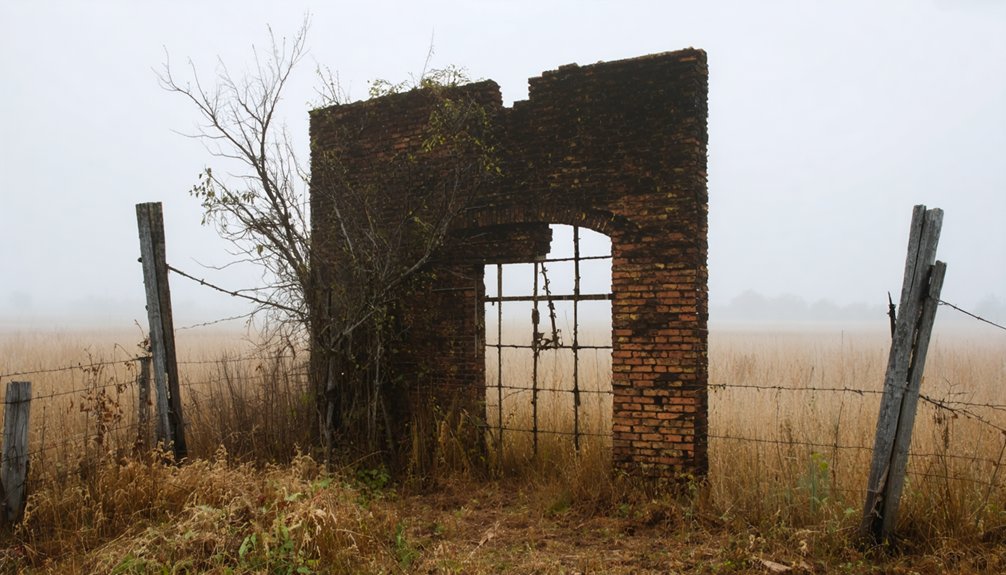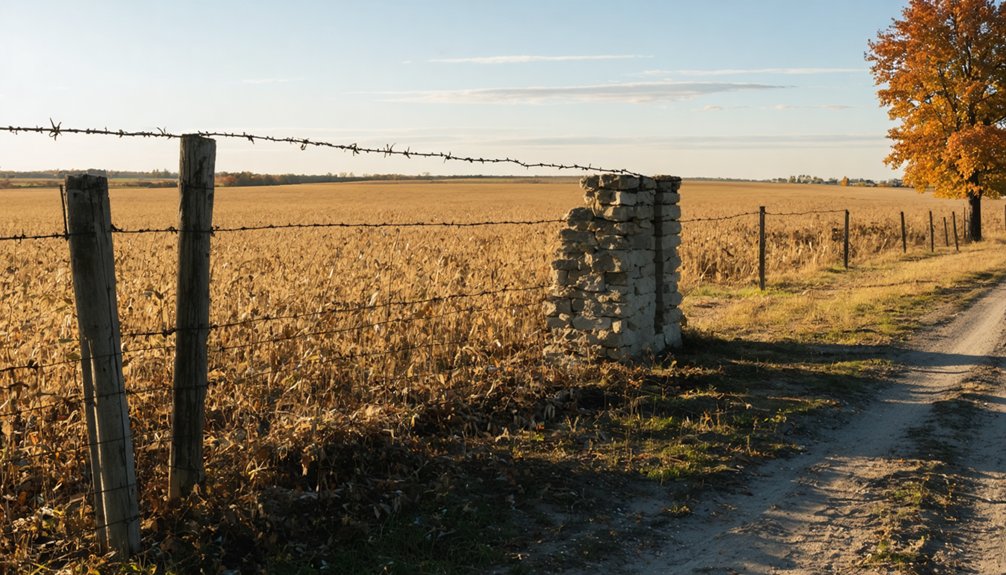You’ll find Orchard Place beneath O’Hare International Airport‘s runways, where a vibrant German farming settlement once thrived. Founded in 1833 as Farwell, the community centered around orchards, St. John’s Evangelical Church, and the Wisconsin Central Railroad stop. World War II brought dramatic change when Douglas Aircraft established a manufacturing plant in 1942. The town vanished as O’Hare expanded, though traces of its rich heritage still whisper through preserved structures and relocated cemeteries.
Key Takeaways
- Orchard Place was a German farming settlement established in 1833 that disappeared due to O’Hare International Airport’s development.
- The town vanished after World War II when its 1,347 acres were acquired for Douglas Aircraft manufacturing and airport expansion.
- Former residents were displaced as the rural community transformed from farmland into industrial and aviation facilities.
- Only a few physical remnants remain, including a 1948 school building, historic farmhouses, and St. John’s Evangelical Church.
- The community’s German heritage and agricultural history are preserved through historical archives and relocated community cemeteries.
From Rural Roots to Railroad Stop: Early Days of Orchard Place
While many Chicago suburbs trace their origins to the railroad era, Orchard Place began as a modest German farming settlement in 1833. Originally named Farwell, the community’s farming practices centered on orchards and agriculture, with German immigrant families establishing homesteads across the fertile Cook County soil. The Farwell Post Office was established in 1881 to serve the growing settlement.
You can still spot evidence of these rural beginnings in the 1830s farmhouse on Pratt Avenue and historic homes along Curtis Street. The community’s spiritual life took root when St. Johns Evangelical Church was constructed in 1873.
The Wisconsin Central Railroad‘s arrival in 1859 transformed the quiet farming community, connecting it to Chicago’s expanding sphere of influence.
When Orchard Place became an official railroad stop in 1887, the railroad impact spurred economic growth beyond agriculture, though the town maintained its agricultural character while embracing new opportunities for trade and transportation.
German Heritage and Community Life in the 1800s
As waves of German immigrants settled in Orchard Place during the 1830s and 1840s, they established a vibrant cultural enclave that would define the community for generations.
You’d find their commitment to cultural preservation most evident at St. John’s Evangelical Church, built in 1873, where services were conducted in German and community festivals brought families together throughout the year.
The town’s social fabric centered on farming, mutual aid, and shared traditions, with German remaining the primary language in homes, schools, and businesses.
At the heart of daily life, you’d see farmers working their orchards while their children attended German-language schools.
Even as the Wisconsin Central Railroad arrived in 1887, bringing modernization, the community maintained its distinct German character through church activities, educational practices, and time-honored customs.
The area’s transformation began during World War II when it was chosen as the location for a new aircraft manufacturing facility in 1942.
The World War II Transformation: Birth of an Airfield
When World War II transformed America’s industrial landscape, Orchard Place’s peaceful farmland became a crucial wartime manufacturing site. In June 1942, you’d have witnessed the War Production Board select this location for its flat terrain and rail access, swiftly acquiring 1,347 acres near Bensenville for Douglas Aircraft‘s new plant.
The site’s transformation showcased American aircraft innovation at its finest. You’d have seen the Austin Company break ground in August 1942, and by November, the first section was already churning out military aircraft. This location would later become an important part of aviation history as the namesake for a major airport.
The facility became a hub of military logistics, producing essential C-54 Skymaster cargo planes that supported Allied operations worldwide. Working around the clock, the plant exemplified the nation’s rapid industrial mobilization, with both civilian and military personnel collaborating to meet wartime demands. The factory’s construction utilized wood and non-strategic materials due to wartime steel shortages.
Vanishing Town: How O’Hare Airport Changed Everything
Before World War II transformed Orchard Place, you’d have found a quiet rural community defined by its sprawling orchards and farmland at the intersection of Higgins and Mannheim roads.
But the war’s demands reshaped this peaceful landscape forever, as the government acquired 1,347 acres for military aircraft production and testing.
After 1945, you wouldn’t recognize the former farming community as urban expansion took hold.
The post-war era swept away the last traces of rural life, leaving behind a landscape transformed by progress and concrete.
The transfer of 1,080 acres to Chicago for civilian aviation marked the beginning of O’Hare International Airport‘s relentless growth.
The once-distinct boundaries of Orchard Place disappeared beneath runways and terminals, becoming a fascinating footnote in aviation history.
This rural hamlet’s transformation from farmland to global transportation hub represents how quickly America’s landscape changed in the mid-20th century.
Preserving the Memory: What Remains of a Lost Community
Despite the dramatic transformation of Orchard Place into O’Hare International Airport, several physical remnants of this lost community still stand as silent witnesses to its rural past.
You’ll find the 1948 school on Maple Avenue, three historic farmhouses along Curtis Street, and an 1830s farmhouse near Craig Drive. The iconic St. John’s Evangelical Church from 1873 continues to mark the town’s religious heritage. Like the old schoolhouse in Coltonville, these buildings provide glimpses into daily life from a bygone era.
While many structures were lost to airport expansion, community archives preserve the town’s memory through photographs, oral histories, and historical records.
The “ORD” airport code serves as a lasting reminder, and relocated cemeteries in Bensenville safeguard the remains of early settlers.
Through historical preservation efforts, these surviving landmarks help tell the story of a once-thriving farming community transformed by modern progress.
Frequently Asked Questions
What Was the Average Population of Orchard Place Before World War II?
Like a gentle breeze through farmland, you’d have found a modest population of several hundred souls at most, though exact numbers weren’t recorded before wartime effects sparked the declining population.
Did Any Notable Historical Figures or Celebrities Come From Orchard Place?
You won’t find any notable residents or celebrities from this community. Historical records don’t identify any significant figures, as the town consisted mainly of German immigrant farmers until its eventual displacement.
What Were the Main Businesses and Industries Besides Farming?
Ever wonder what drove this area’s economy? Beyond farming, you’d find the massive Douglas Aircraft factory employing 15,000 workers, railroad operations serving multiple transport routes, and small commercial businesses near Mannheim and Higgins.
How Much Did Typical Farmland Cost in Orchard Place During the 1800S?
You’d have found farmland prices in the area ranging from $1.25 to $2.00 per acre, following typical agricultural trends for Illinois frontier land during the early-to-mid 1800s.
Were There Any Major Natural Disasters That Affected Orchard Place?
You won’t find records of major natural disasters affecting this area. Neither floods, tornadoes, nor earthquakes shaped its fate – it’s the human-driven expansion of O’Hare Airport that transformed the landscape.
References
- https://en.wikipedia.org/wiki/Orchard_Place
- https://illinoisstateonline.com/ghost-towns-in-illinois/
- https://en-academic.com/dic.nsf/enwiki/9691165
- http://ghosttowns.com/states/il/orchardplaceillinois.html
- http://livinghistoryofillinois.com/pdf_files/Orchard Place
- https://drloihjournal.blogspot.com/2022/08/lost-towns-of-illinois-orchard-place.html
- https://www.cirrusimage.com/ord/
- https://archive.org/details/germanimmigratio00koch
- https://alcpress.org/military/afplants/orchard-place/index.html
- https://www.aahs-online.org/pubs/journals/files/582114.pdf



